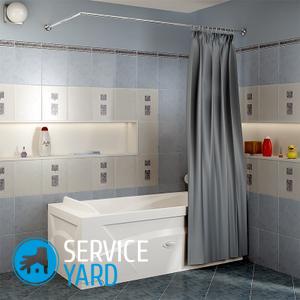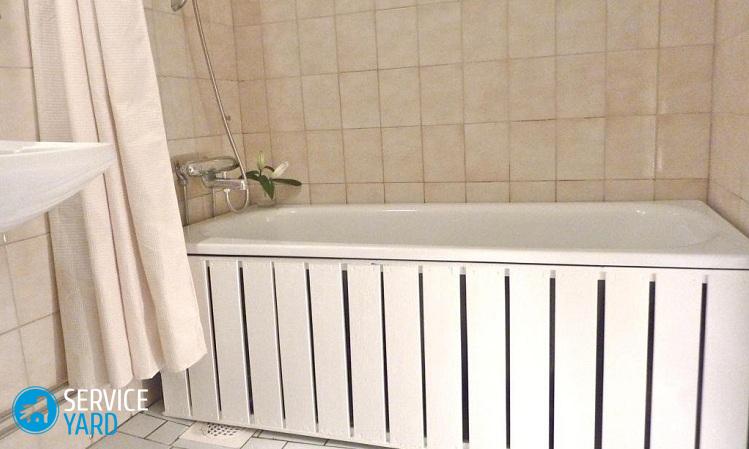How to close the bottom bath with your own hands?

Standard bathrooms are generally small in size. Therefore, it is desirable that some elements of the interior can perform several functions simultaneously. So, screens for bathtubs help hide the unattractive appearance of the side walls of a plumbing font and sewer communications, and also act as a decoration element. Let's find out what these structures are, what they are made of, how to close the bath from below with your own hands.
to contents ↑Types of screens for the bathroom
The screen is a special design that allows you to close the sides of the bathtub, which are visible from floor to edge. It can be made of different materials and have completely different types and configurations.
Blank construction
It is a continuous canvas, makes the appearance of the bathroom more accurate. However, it has one significant drawback - it will not work to use the space under the bathroom.
With sliding or hinged doors
This is the most functional version of the bath screen, as it provides free access to the space under the bath and allows you to use it to store various things, such as cosmetics, towels or cleaning products.
Shelf design
Or, as it can be called differently, a screen-locker. Often it has a back wall, which greatly limits the size of the shelves and makes it difficult to access the sewer.
Important! It is sometimes equipped with retractable pallets, which can give the device additional functionality.
Waterproof curtain
The most budget option to close the bottom of the bath with your own hands. Curtains are often used instead of the screen for custom size fonts.
to contents ↑Important! In addition, the screens can be frontal and frontal, covering the bathing tank side or front.
Which screen option to choose?
The advantages of a decorative panel with hinged or sliding doors for a standard rectangular bath are obvious:
- Affordable price.
- Availability of finished products on sale.
- Providing quick access to communications.
- Simple and uncomplicated installation.
When choosing a screen with hinged or sliding doors, special attention should be paid to the material from which the fittings are made. Since plastic parts can break very quickly, it is desirable that all components be made of corrosion-resistant metal.
Important! For any screen options, the presence of a technological window (opening) is mandatory, which provides access to the sewer nodes.
The most common screen sizes for rectangular acrylic bathtubs:
- width 1.5-1.7 m;
- height 0.5-0.56 m.
Materials for screens
When choosing a screen to close the bath from the bottom with your own hands, it is very important to consider the characteristics of the materials from which they are made. Let's look at all the options in more detail so that you can make the only decision that is right for the conditions of your bathroom.
Brick structure
Brick, which requires finishing, is laid out in masonry in half a brick, and then decorated with mosaics, ceramic tiles or other materials.
Important! The advantages include the availability of space for design, and the disadvantages are the fundamental nature of the design, since brickwork will have to be dismantled if necessary, a complex repair of sewage systems.
Among the features of such an installation, the following can be noted:
- Brick masonry rules apply - each subsequent row is shifted by half a brick.
- Near the drain of water a window is made, closed with a special plastic door.
- A 2 cm gap is left under the edge of the bath, which is then sealed with foam.
- In the middle of the design, it is recommended to arrange a notch for the legs to ensure convenience and comfort not only when using the font itself, but also washing, and other procedures in the bathroom.
- The construction process is quite laborious, requires specific knowledge, professional tools.
Important! If you perform the cladding from mirror panels, this will help to visually increase the space.
Moisture-resistant drywall
Just like for bricks, finishing with stucco and tile is mandatory for this material. Plasterboard sheets are sewn onto a metal frame or a frame made of wooden beams.
Among the features of such a fastening, one can distinguish the following:
- Self-tapping screws should be selected so that they do not damage the acrylic bath.
- In order to avoid contact of the gypsum plasterboard with water, a gap of 1 cm (between the lower border of the canvas and the floor covering) must be left below on the floor.
- In view of the possible swelling of the material on top of the canvas, a gap of 1 cm is left.
- If a wooden beam is used, then it must be treated with a special antifungal composition.
- In the center of the structure, it is desirable to provide leg cavities.
Important! The main advantage is the ability to create designs of any shape. And of the shortcomings can be called a relatively short life and multi-stage during installation work.

MDF
Such designs are made of special plates, which are coated with a special moisture-resistant film. The subtleties of installation are similar to the features of the installation of drywall panels.
Among the advantages of MDF structures, the following can be distinguished:
- A varied selection of colors and patterns.
- Affordable price.
- Simplicity and ease of maintenance - just wipe with a sponge or a damp cloth.
- A wide selection of designs - solid web, with sliding or hinged doors.
However, there are also disadvantages:
- Not too long life.
- Deformation susceptibility due to constant exposure to moisture.
- Inability to use detergents with abrasive additives.
Plastic and polystyrene
Plastic and polystyrene panels are the most common way to close the bath from below with your own hands.
Of the advantages we can distinguish:
- Quite a long service life.
- Convenience and simplicity in leaving - special detergents are not required, just wipe the panels with a damp sponge with the addition of any detergent.
- A huge palette of drawings and colors.
- Scratch resistant.
- A wealth of types, sizes and shapes.
- Installation does not require special skills and tools.
- Plastic products can be purchased at almost any hardware store.
The installation sequence of such structures is very simple:
- The upper part of the screen is led under the side of the bathroom.
- The panel is arranged vertically.
- The design is tightly fixed with adjustable legs.
Acrylic
Another option for bath screens is acrylic products. The following can be said about them:
- Acrylic screens often come with bathtubs of the same material, although they can also be sold separately.
- As a rule, such screens are made of plastic coated on top with a layer of acrylic.
- Sometimes they repeat the rather complicated shape of the font and close the wires for sanitary products with built-in hydromassage.
- Sometimes they have recesses for legs, which allows you not to rest your feet on the panel, standing near the bath.
Glass
For glass structures that cover the front and side walls of the bathroom, shockproof or tempered glass is used. A bathroom with such a screen looks expensive and exclusive.
Important! The product can be transparent, matte, mirrored, decorated with drawings or patterns.
Wood
Wooden panels will appeal to adherents of natural and environmentally friendly materials. The main condition when using natural wood is the processing of the material with special water-repellent impregnation.
Screen in the form of a curtain
Screens in the form of curtains can be made of different materials, for example, polyester, PVC (polyvinyl chloride), textile with special impregnation. About this option, close the bottom of the bath with your own hands, you can say the following:
- Mounting on a string will be appropriate if there is a side at the bathroom.
- The metal frame must be treated with an anti-corrosion agent.
- Finished baguettes are usually equipped with nuts.
- Very easy to install.
- Have a reasonable price.
- Provide free access to communications.
- Easy to manufacture with your own hands.
- Provide a wide scope for design solutions.
to contents ↑Important! Among the shortcomings can be called the need for special care - washing, for which you need to provide a simple way to disassemble the mounting system.
Screen Mounting Steps
Most often, installation of a design for bathrooms includes the following steps:
- Making detailed measurements.
- Marking frame mounts.
- Assembly and installation of the frame.
- Panel Installation
- Finishing work.
to contents ↑Important! It must be remembered that the bathroom should never rest on the screen.
Stock footage
Often, manufacturers of plumbing equipment apply the appropriate installation instructions to close the bottom of the bath with their own hands. But if you do not have the desire or ability to make and install panels yourself, then seek help from specialists.
- How to choose a vacuum cleaner taking into account the characteristics of the house and coatings?
- What to look for when choosing a water delivery
- How to quickly create comfort at home - tips for housewives
- How to choose the perfect TV - useful tips
- What to look for when choosing blinds
- What should be running shoes?
- What useful things can you buy in a hardware store
- Iphone 11 pro max review
- Than iPhone is better than Android smartphones




